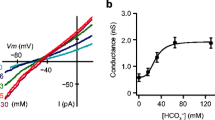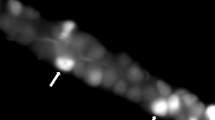Abstract
Ionic conductance properties of the basolateral cell membrane of oxyntic cells were studied in frog gastric fundus in vitro. After mounting the fundus in a modified Ussing chamber the serosal connective tissue was dissected off and individual oxyntic cells were punctured from the serosal surface with microelectrodes. Under resting conditions the membrane potential averaged −56.9, SD±9.5 mV (n=63), cytoplasm negative. Lowering or raising serosal HCO −3 concentration from 17.8 to 6 or 36 mmol/l respectively at constant\(p_{CO_2 } \) depolarized or hyperpolarized the cell membrane by +16.7 or −18.2 mV respectively. Sudden removal of serosal Na+ also depolarized the cell membrane (anomalous Nernst response). Since both the HCO −3 dependent and the Na+ dependent potential changes were strongly depressed by the disulfonic stilbene SITS and since the potential response to HCO −3 was virtually abolished in Na+-free solution we conclude that a rheogenic Na+ (HCO −3 ) n -cotransport system (n>1) is present in the basolateral cell membrane of oxyntic cells. Its possible role in base transfer during HCl-secretion or HCO −3 secretion remains to be elucidated.
Similar content being viewed by others
References
Bello-Reuss E (1982) Electrical properties of the basolateral membrane of the straight portion of the rabbit proximal renal tubule. J Physiol 326:49–63
Blum AL, Hirschowitz BI, Helander HF, Sachs G (1971) Electrical properties of isolated cells of Necturus gastric mucosa. Biochim Biophys Acta 241:261–272
Boron WF, Boulpaep EL (1983) Intracellular pH regulation in the renal proximal tubule of the salamander. Basolateral HCO −3 -transport. J Gen Physiol 81:53–94
Burckhardt B-Ch, Cassola AC, Frömter E (1984) Electrophysiological analysis of bicarbonate permeation across the peritubular cell membrane of rat kidney proximal tubule. II. Exclusion of HCO −3 -effects on other ion permeabilities and of coupled electroneutral HCO −3 -transport. Pflügers Arch 401: 43–51
Burckhardt B-Ch, Sato K, Frömter E (1984) Electrophysiological analysis of bicarbonate permeation across the peritubular cell membrane of rat kidney proximal tubule. I. Basic observations. Pflügers Arch 401:34–42
Carrasquer G, Chu TC, Rehm WS, Schwartz M (1982) Evidence for electrogenic Na-Cl-symport in the in vitro frog stomach. Am J Physiol 242:G620-G627
Carrasquer G, Kissel D, Rehm WS, Schwartz M (1983) Anomalous potential difference responses to changes in sodium concentration in the antrum of frog stomach. Am J Physiol 245:G554-G561
Curci S, Schettino T (1984) Effect of external sodium on intracellular chloride activity in the surface cells of frog gastric mucosa. Microelectrode studies. Pflügers Arch 401:152–159
Curci S, Schettino T, Frömter E (1986) Histamine reduces Cl− activity in surface epithelial cells of frog gastric mucosa. Suggestive evidence for ionic coupling between surface epithelial and oxyntic cells. Pflügers Arch 406:204–211
Demarest JR, Machen TE (1985) Microelectrode measurements from oxyntic cells in intact Necturus gastric mucosa. Am J Physiol 249:C535-C540
Flemström G, Sachs G (1975) Ion transport by amphibian antrum in vitro. I. General characteristics. Am J Physiol 228:1188–1198
Frömter E (1986) The electrophysiological analysis of tubular transport. Kidney Intern 30:216–228
Hogben CAM, Kent TH, Woodward PA, Sill AJ (1974) Qualitative histology of the gastric mucosa: man, dog, cat, guinea pig and frog. Gastroenterology 67:1143–1154
Ito S (1967) Anatomic structure of the gastric mucosa. In: CF Code (ed) Handbook of physiology, alimentary canal, vol 2. Am Physiol Soc, Washington DC, pp705–741
Jentsch TJ, Koller SK, Koch M, Wiederholt M (1984) Evidence for coupled transport of bicarbonate and sodium in cultured bovine corneal endothelial cells. J Membr Biol 81:189–204
Jentsch TJ, Matthes M, Keller SK, Wiederholt M (1985) Anion dependence of electrical effects of bicarbonate and sodium on cultured bovine corneal endothelial cells. Pflügers Arch 403:175–185
Rehm WS, Sanders SS (1975) Implications of the neutral carrier Cl−-HCO3-exchange mechanism in the gastric mucosa. Ann N Y Acad Sci 246:442–455
Sanders SS, O'Callaghan J, Butler CF, Rehm WS (1972) Conductance of submucosal-facing membrane of frog gastric mucosa. Am J Physiol 222:1348–1354
Schettino T, Curci S, Ceglie L, Zambonin-Zallone A, Frömter E (1985) Microelectrode studies on oxyntic cells in intact frog gastric mucosa. Congresso SIBS-SIF-SINU, Abstract 51
Schwartz M, Carrasquer G, Rehm WS (1985) Evidence for HCO −3 -conductance pathway in nutrient membrane of bullfrog antrum. Biochim Biophys Acta 816:251–257
Schwartz M, Carrasquer G, Rehm WS (1985) Evidence for HCO −3 -conductance pathways in nutrient membrane of resting frog fundus. Biochim Biophys Acta 819:187–194
Shoemaker RL (1978) Micropuncture studies using the amphibian fundic gastric mucosa, in vitro. In: Öbrink KJ, Flemström G (eds) Gastric ion transport. Acta Physiol Scand (Spec Suppl) pp 173–180
Soleimani M, Grassel SM, Aronson PS (1986) Stoichiometry of the NaHCO −3 cotransport system in renal basolateral membrane vesicles. Clin Res 34:609 A
Villegas L (1962) Cellular location of the electrical potential difference in frog gastric mucosa. Biochim Biophys Acta 64:359–367
Yoshitomi K, Frömter E (1984) Cell pH of rat renal proximal tubule in vivo and the mechanism of peritubular HCO −3 -exit. Pflügers Arch 402:300–305
Yoshitomi K, Burckhardt B-Ch, Frömter E (1985) Rheogenic sodium-bicarbonate cotransport in the peritubular cell membrane of rat renal proximal tubule. Pflügers Arch 405:360–366
Yoshitomi K, Frömter E (1985) How big is the electrochemical potential difference of Na+ across rat renal proximal tubular cell membrane in vivo? Pflügers Arch 405:S121-S126
Author information
Authors and Affiliations
Additional information
This work was supported by grants Nr. 85.0443.04 and 86.00048.04 from Consiglio Nazionale delle Ricerche, Rome, Italy and by grant Nr. I 37736 from Stiftung Volkswagenwerk, Hannover, FRG
Rights and permissions
About this article
Cite this article
Curci, S., Debellis, L. & Frömter, E. Evidence for rheogenic sodium bicarbonate cotransport in the basolateral membrane of oxyntic cells of frog gastric fundus. Pflugers Arch. 408, 497–504 (1987). https://doi.org/10.1007/BF00585075
Received:
Accepted:
Issue Date:
DOI: https://doi.org/10.1007/BF00585075




